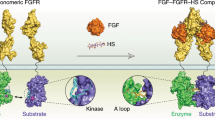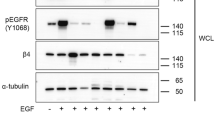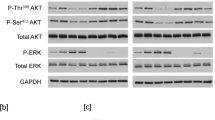Abstract
Autophosphorylation of type I receptor tyrosine kinases (RTKs) comprises one step in the signaling events mediated by erbB receptors such as p185neu and EGFR. Previous analysis of p185neu has indicated that there are at least five tyrosine autophosphorylation sites, Y882, Y1028, Y1143, Y1226/7 and Y1253, of which Y882 might be important because of its location in the kinase activity domain. We have specifically analysed the effect of a Y882F (phenylalanine substituted for tyrosine at position 882) mutation in the enzymatic active domain. We also deleted the carboxyl terminal 122 amino acids which contained three other autophosphorylation sites (TAPstop) and combined mutants of that deletion with Y882F (Y882F/APstop). Both in vitro and in vivo transformation assays showed that substitution of tyrosine882 by phenylalanine significantly decreased the transforming potential of activated, oncogenic p185neu, although no significant difference in the total phosphotyrosine levels of the mutant proteins were observed. To analyse mitogenic signaling in response to ligand, the intracellular domains of p185neu and Y882F were fused with the extracellular domain of the EGF receptor. The proliferation of cells expressing these chimeric receptors was EGF-dependent, and cells expressing EGFR/Y882F chimeric receptors were less responsive to EGF stimulation than those expressing EGFR/neu receptors. In vitro kinase assays demonstrated that abolishing the autophosphorylation site Y882 diminished the enzymatic tyrosine kinase activity of p185neu. These studies, taken together with the phenotypic inhibition observed with cells expressing Y882F, suggest that the tyrosine882 residue may be important for p185neu-mediated transformation by affecting the enzymatic kinase function of the p185neu receptor.
This is a preview of subscription content, access via your institution
Access options
Subscribe to this journal
Receive 50 print issues and online access
$259.00 per year
only $5.18 per issue
Buy this article
- Purchase on Springer Link
- Instant access to full article PDF
Prices may be subject to local taxes which are calculated during checkout
Similar content being viewed by others
Author information
Authors and Affiliations
Rights and permissions
About this article
Cite this article
Zhang, HT., O'Rourke, D., Zhao, H. et al. Absence of autophosphorylation site Y882 in the p185neu oncogene product correlates with a reduction of transforming potential. Oncogene 16, 2835–2842 (1998). https://doi.org/10.1038/sj.onc.1201820
Received:
Revised:
Accepted:
Published:
Issue Date:
DOI: https://doi.org/10.1038/sj.onc.1201820
Keywords
This article is cited by
-
Protein kinase Cδ is required for ErbB2-driven mammary gland tumorigenesis and negatively correlates with prognosis in human breast cancer
Oncogene (2014)
-
Phosphoproteomic mass spectrometry profiling links Src family kinases to escape from HER2 tyrosine kinase inhibition
Oncogene (2011)
-
The c-Src tyrosine kinase associates with the catalytic domain of ErbB-2: implications for ErbB-2 mediated signaling and transformation
Oncogene (2005)
-
Tyrosine kinase signalling in breast cancer: Epidermal growth factor receptor and c-Src interactions in breast cancer
Breast Cancer Research (2000)



